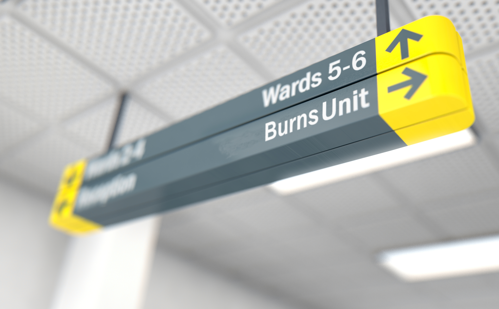
Patients with severe burns are highly vulnerable to infection due to extensive skin barrier damage and changes to the innate immune system in response to the burn injury. Simultaneously burns patients may pose a risk of spreading micro-organisms to other burns patients and other individuals via infection and colonisation of burn injuries. The global spread of multidrug-resistant organisms presents an additional threat.
 In 1991, a working group of the British Burn Association and the then Hospital Infection Society published a landmark report focusing on the design of burns units from an IPC perspective. Until now, there has been no updated guidance addressing IPC in burns services including the physical environment which included the application of a rigorous evidence synthesis.
In 1991, a working group of the British Burn Association and the then Hospital Infection Society published a landmark report focusing on the design of burns units from an IPC perspective. Until now, there has been no updated guidance addressing IPC in burns services including the physical environment which included the application of a rigorous evidence synthesis.
The new 2025 guidance, the result of many years of collaboration and perseverance, brings together the expertise and perspectives of a multidisciplinary group including burns clinicians, research scientists, IPC professionals and a patient representative. It includes a systematic literature review, best practice recommendations and a robust framework to inform future research.
Key areas addressed include:
The systematic literature review covers other aspects of burn care including antimicrobial prophylaxis, antiseptics and burn wound dressings; cleaning and disinfection (decontamination); and microbiological screening and diagnostic sampling.
The updated guidance reflects real-world experience and acknowledges that implementation must be workable and adaptable to local circumstances. Public consultation with burns and IPC professionals and patient organisations has helped ensure that the recommendations are practical and multidisciplinary in scope.
Many of the new recommendations, such as the revised ventilation strategy for burns theatres, will be especially relevant for new hospital builds and refurbishments rather than modifying existing estate. The guidance identifies key priorities for future research both in terms of topic areas and strengthening the quality of clinical studies for evaluating infection prevention strategies for this unique patient group.
Pauline Jumaa, Chair of the Burns Working Party, said:
“Patients with severe burns have some of the most complex IPC challenges in modern healthcare. This guidance is the result of years of work by burns clinicians, researchers and IPC specialists working with burns services to bring together the best current evidence and practical experience. We hope it will support burns services and IPC teams with a realistic framework to improve patient safety and to help plan future research to reduce the risk of infection for this vulnerable patient population.”
Manjula Meda, Chair of HIS, said:
“Publishing this updated burns IPC guidance demonstrates HIS’s commitment to supporting healthcare teams with the very best evidence and practical advice. This work builds on the foundations set over three decades ago, and we are proud to see it shaped by multidisciplinary collaboration, rigorous evidence review and public consultation.”
The full guidance is published in the Journal of Hospital Infection and is freely available to download.